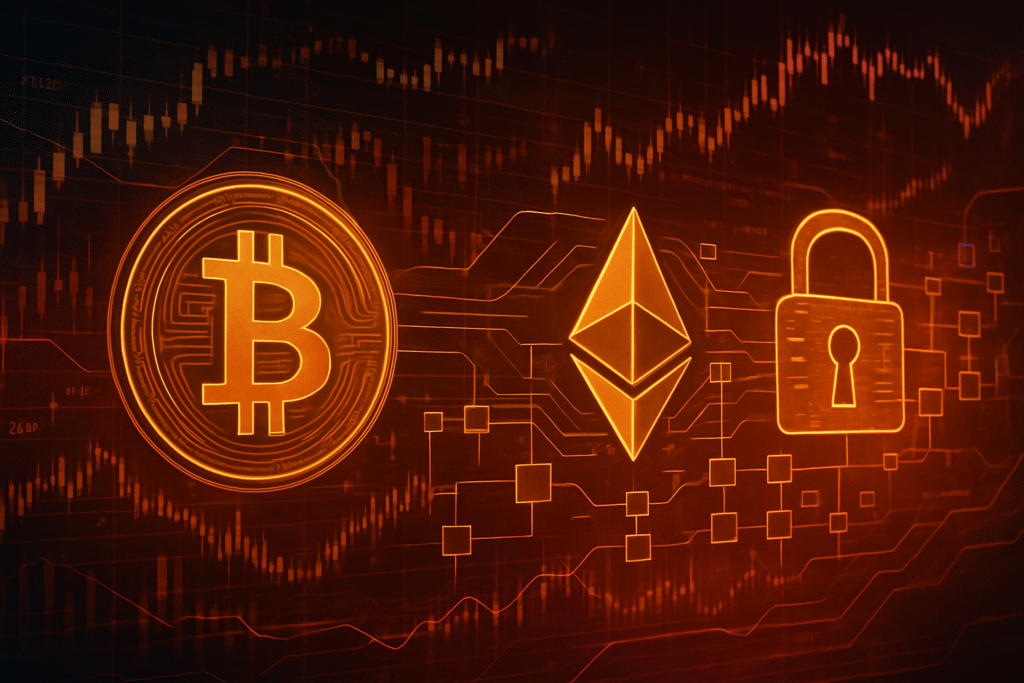Financial News
U.S. Sanctions Hammer Crypto, Exchanges Scramble: OKX Bolsters Compliance Amidst Record Forfeiture

The cryptocurrency world is reeling from a massive, coordinated enforcement action by U.S. and UK authorities, which saw the U.S. Department of the Treasury's Office of Foreign Assets Control (OFAC) and FinCEN, alongside their British counterparts, sanction the sprawling Prince Group Transnational Criminal Organization on October 14, 2025. This unprecedented move targeted 146 associated individuals and entities, including prominent cryptocurrency platforms like Byex Exchange and financial service providers such as Huione Group, for their roles in "pig butchering" scams, human trafficking, and laundering billions of dollars through digital assets. The enforcement culminated in the largest forfeiture in U.S. Department of Justice history: approximately 127,271 Bitcoin, valued at a staggering $15 billion.
The immediate fallout from this landmark announcement has sent shockwaves across the global crypto community. Coming just a day before the current date of October 15, 2025, the sheer scale of the bitcoin seizure and the direct targeting of crypto entities involved in illicit activities have triggered a fresh wave of compliance actions from exchanges worldwide. This event underscores a hardening stance from global regulators, reinforcing that the era of lax oversight in the digital asset space is definitively over. For the crypto ecosystem, this matters immensely, as it signals a crucial turning point where legitimacy and stringent adherence to financial regulations become non-negotiable for survival and mainstream adoption. The message is clear: participate in illicit finance, and face the full might of international law enforcement.
Market Impact and Price Action
The immediate market reaction to the October 14, 2025 sanctions against the Prince Group and its associated crypto entities was one of sharp caution and increased volatility. While Bitcoin's (BTC) price, already under broader macroeconomic pressures, saw a modest dip of around 2-3% in the hours following the announcement, the true impact was felt more acutely in the altcoin market and across platforms perceived to have weaker compliance frameworks. Trading volumes on decentralized exchanges (DEXs) saw a temporary uptick as some users sought to move away from centralized platforms, though this was quickly overshadowed by a general flight to quality.
Specifically, tokens associated with smaller, less regulated exchanges or projects that had even tangential connections to the sanctioned entities experienced significant sell-offs, with some losing upwards of 10-15% of their value within 24 hours. The immediate liquidity impact was most pronounced on the sanctioned Byex Exchange, which effectively ceased operations, trapping user funds and causing widespread panic among its user base. This event served as a stark reminder of the counterparty risks inherent in less regulated platforms. Technical analysis suggests that Bitcoin quickly found support around the $115,000 mark, a level that had previously acted as strong resistance, now serving as a critical psychological and technical anchor amidst the regulatory uncertainty.
This event bears a striking resemblance to the market's reaction following the November 2023 Binance settlement, where the exchange paid a colossal $4.4 billion for AML and sanctions violations. In both cases, the market experienced initial jitters, followed by a period of consolidation as compliant exchanges reiterated their commitment to regulatory frameworks. However, the current situation is arguably more severe due to the direct seizure of a record $15 billion in Bitcoin, demonstrating a heightened capability of law enforcement to trace and confiscate digital assets used in illicit activities. This record forfeiture sets a new precedent, indicating that the consequences for non-compliance are not just fines but also significant asset confiscation.
The long-term market effect is likely to be a continued consolidation of trading volume on exchanges with robust KYC (Know Your Customer) and AML (Anti-Money Laundering) procedures. Investors and institutions are increasingly prioritizing regulatory certainty, making compliance a key differentiator. While the immediate price action reflects short-term fear, the broader trend points towards a maturation of the market, where legitimate, regulated entities are favored, potentially paving the way for greater institutional adoption in the long run.
Community and Ecosystem Response
Social media platforms like Crypto Twitter and Reddit immediately erupted with discussions following the October 14th sanctions. Sentiment was a mixed bag: relief among those advocating for stricter regulation and a "cleaner" crypto space, and alarm among others who viewed it as government overreach or a threat to crypto's decentralized ethos. Many prominent crypto influencers and thought leaders quickly weighed in, with some applauding the crackdown on illicit actors as necessary for the industry's long-term health and legitimacy. Others expressed concerns about the precedent set by such large-scale seizures and the potential for future actions to impact privacy or legitimate decentralized finance (DeFi) activities.
The immediate effect on related DeFi protocols and NFT projects was less direct but still palpable. Projects with even remote perceived connections to the sanctioned entities or those operating with less transparent governance models saw increased scrutiny from their communities. While the core tenets of DeFi—decentralization and censorship resistance—were often cited as a bulwark against such centralized enforcement, the reality is that many DeFi projects still rely on centralized interfaces or interact with centralized stablecoin issuers, making them indirectly vulnerable to regulatory pressures. NFT markets, which often reflect broader crypto sentiment, experienced a slight cooling as investors became more risk-averse, though no specific NFT projects were directly implicated in the Prince Group sanctions.
Broader crypto Twitter and Reddit sentiment largely coalesced around a few key themes: the inevitability of increased regulation, the importance of self-custody for assets, and a renewed focus on identifying and avoiding "rug pulls" and scam projects. There was a clear divide between those who believe these actions are a necessary step towards mass adoption by legitimizing the space and those who fear it erodes the foundational principles of crypto. The conversation also highlighted the growing sophistication of law enforcement in tracing blockchain transactions, dispelling the myth of complete anonymity for illicit actors.
What's Next for Crypto
The recent U.S. sanctions and record Bitcoin forfeiture signal a new chapter for the cryptocurrency market, characterized by heightened regulatory scrutiny and a relentless pursuit of illicit actors. In the short-term, we can expect continued volatility as exchanges and projects scramble to update their compliance frameworks and as investors digest the implications of such aggressive enforcement. There will likely be a "flight to quality," with capital flowing towards well-regulated, established exchanges and projects that demonstrate robust KYC/AML procedures. This could lead to a temporary dampening of innovation in areas perceived as regulatory grey zones, but also a surge in demand for compliance-focused blockchain solutions.
Long-term implications point towards a more mature and legitimate crypto ecosystem. The era of operating in regulatory shadows is rapidly drawing to a close. This could pave the way for greater institutional adoption, as clearer rules and reduced illicit activity make the space more palatable for traditional finance. Potential catalysts to watch include further international cooperation on crypto regulation, the development of more sophisticated on-chain analytics tools by law enforcement, and potentially, new legislative frameworks in major economies that explicitly define digital asset classes and their regulatory requirements.
Strategic considerations for projects and investors are paramount. Projects must prioritize robust compliance from day one, investing heavily in legal counsel, KYC/AML technologies, and transparent governance. Failure to do so risks not just fines, but existential threats, as demonstrated by the Byex Exchange situation. Investors, conversely, must conduct thorough due diligence, favoring projects and platforms with clear regulatory adherence and strong security practices. The days of chasing speculative gains on unregulated platforms without considering compliance risk are over.
Possible scenarios include a bifurcation of the crypto market: a highly regulated, compliant sector attracting institutional capital and fostering mainstream adoption, and a smaller, more clandestine "dark crypto" sector for illicit activities, which will face ever-increasing pressure from global law enforcement. The likelihood of the former scenario dominating is high, as governments worldwide are aligning to bring digital assets under existing financial oversight.
Bottom Line
The U.S. sanctions against the Prince Group and the unprecedented $15 billion Bitcoin forfeiture on October 14, 2025, represent a watershed moment for the cryptocurrency industry. For crypto investors and enthusiasts, the key takeaway is clear: regulatory compliance is no longer an option but a fundamental requirement for participation in the legitimate digital asset economy. Platforms like OKX (OKX: OKX) have already demonstrated their commitment to adapting, with immediate announcements of heightened AML controls and a long-term strategy involving external compliance consultants, a direct result of their own February 2025 settlement for AML violations.
This event underscores the long-term significance of a maturing market. While some may lament the increased government intervention, the crackdown on illicit finance is a necessary step towards achieving broader crypto adoption and integration into the global financial system. It reinforces the notion that transparency, accountability, and adherence to international financial laws are indispensable. The market is evolving from a wild west into a more structured environment, which, while potentially stifling for some aspects of perceived decentralization, is crucial for attracting institutional capital and ensuring consumer protection.
Final thoughts on what this means for crypto adoption lean towards a more legitimate, but also more constrained, future. The narrative of crypto as an unregulated haven for illicit activity is being systematically dismantled. This will undoubtedly accelerate mainstream acceptance, but also necessitates a shift in mindset for participants, who must now navigate a landscape where regulatory adherence is paramount. Important metrics to monitor include the enforcement actions taken by other global regulators, the continued development of on-chain analytics capabilities, and the legislative progress in major jurisdictions regarding digital asset frameworks. The industry's ability to innovate within these new boundaries will define its trajectory.
This article is for informational purposes only and does not constitute financial or investment advice. Cryptocurrency investments carry significant risk.
More News
View More




Quotes delayed at least 20 minutes.
By accessing this page, you agree to the following
Privacy Policy and Terms Of Service.




